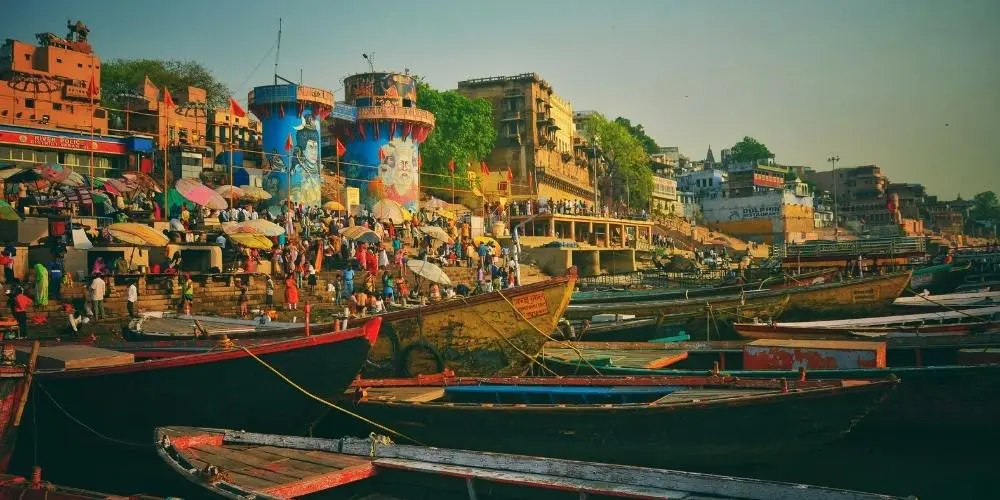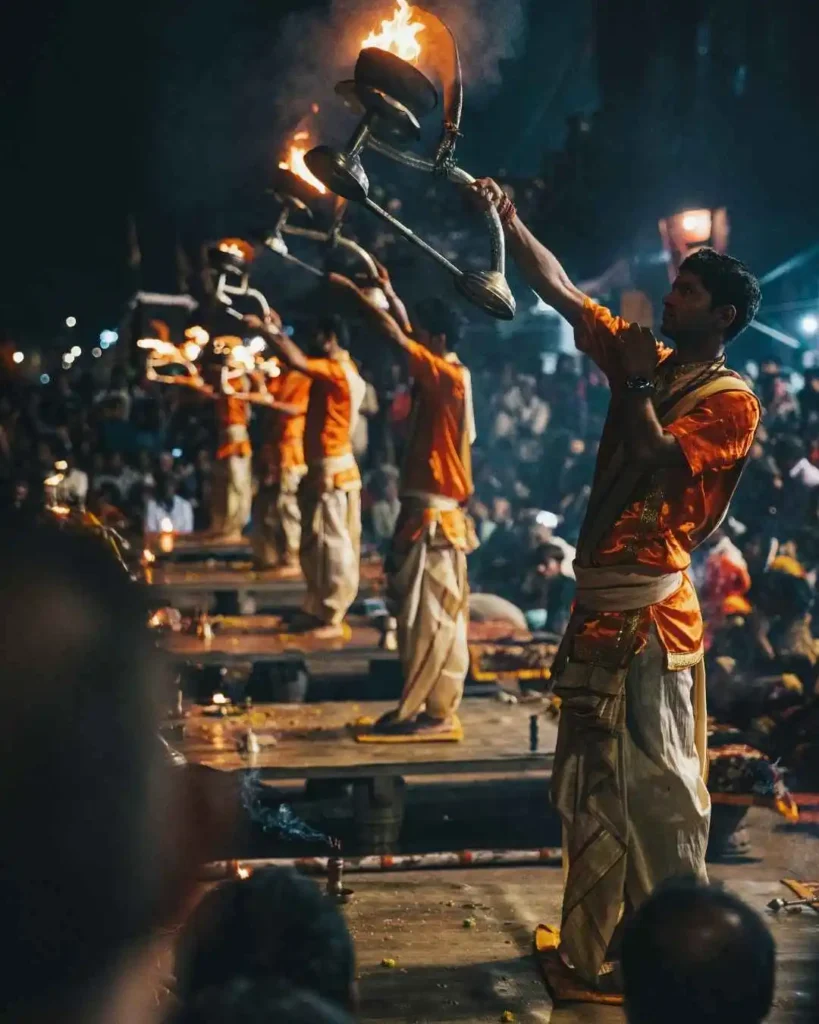Varanasi is a paradox; it’s an untamed heartbeat that resonates with every traveller. A day in Varanasi is a surreal experience, beginning with being surrounded by the glow of the ghats, incense twirling in the mist, and the chorus of temple bells. By afiernoon, you’re absorbing the slow chaos over a cup of chai near BHU, listening to the student banter and the rustle of ancient peepal trees. By the evening you stroll around the bazaars, making pitstops at various chaat corners to reach just in time for the evening aarti on the ghats, and once there you drown your senses in the devotional atmosphere. The city reels you in, not only with its spiritual electricity, but also with its deep pockets of calm, creativity, and very human contradictions.
If you’re planning to visit Varanasi, be warned: you’re about to be swept up by more than just a pilgrimage. It’s a full-eyed dive into India’s soul, where everyday life is anything but ordinary.
Iconic Places to Visit in Varanasi
Though temples and ghats are on everyone’s bucket list while visiting Varanasi, this guide takes you to all the right spots and beyond:
- Dashashwamedh Ghat: Of the famous Ganges ghats, the most loved one is Dashashwamedh Ghat, which is bustling with sadhus and priests performing rituals when the sun shines bright. By the evening, the ghat transforms into pure magic with the Ganga Aarti where priests swirl fire along with synchronized chants rising skyward, while the petals and prayers float downstream.

- Sarnath: The place known for the delivery of Buddha’s first sermon in 528 BCE. This green and serene world is just 10km outside Varanasi, where you can walk through grand stupas, whispering Bodhi trees, and the evocative Sarnath Museum.
- Ramnagar Fort: Across the river sits this fading 17th-century palace. Inside, you’ll find a museum with vintage cars, medieval weaponry, and eerie, dust-coated halls.
- Bharat Kala Bhavan (BHU Campus): If you crave quiet, art, and a bit of a time-travel in the past, this museum stuns with Mughal miniatures, folk art, and works by legends like Raja Ravi Varma in its sculpture-filled courtyards, and legendary libraries.
Kashi Vishwanath Temple
The city’s spiritual epicenter, rebuilt in 1780 by Maharani Ahilya Bai Holkar of Indore is crowned with a gold-plated spire, and alive with devotees. Kashi Vishwanath Temple is a revered Hindu shrine dedicated to Lord Shiva. The temple houses one of the twelve Jyotirlingas, a radiant representation of Lord Shiva, known as Vishweshwara or Vishwanath. A well known as the Jnana Vapi (Wisdom Well) is located to the north of the temple. Getting inside is an experience in itself; reach early to avoid the heaviest crowds.

Ganga Aarti, Varanasi
Note: It is also important to be dressed appropriately to enter the temple premises.
BHU Varanasi: A Campus That Breathes History
Banaras Hindu University or BHU, as everyone calls it, is more than a prestigious university. Founded in 1916 by Madan Mohan Malaviya, it sprawls across 1,300 acres and is dotted with mango groves, Indo-colonial buildings, and a beautiful Saraswati Temple. In addition, there is a new Vishwanath Temple on campus, designed to be a center of peace and inclusivity. The highlight of the day at BHU is simply sipping lemon tea under the shade, soaking up the constant, lyrical debate between science and poetry that makes the campus so alive.
Best Hotels in Varanasi
Pick a hotel that matches your purpose of visit and must-sees.
- The best luxury stay option is the BrijRama Palace. Atop the Darbhanga Ghat, this boutique hotel spells royalty. You get river-facing suites, live classical performances at dawn, and walls steeped in history.
- Hotel Surya near Godowlia is one of the best mid-range options available. It blends heritage decor with modern touches. Its proximity to the Kashi Vishwanath Temple adds to the perks of staying here.
- For the backpackers, Zostel Varanasi keeps things social, friendly, and affordable.
Quick Tip: When booking a stay, prioritize hotels close to the ghats or BHU for easy access to the city’s rhythms. If you love sleep, maybe steer clear of “ghat view” rooms unless you’re ready for 5am temple bells!
How to Reach Varanasi
Varanasi is very well-connected via air, rail, and road. Lal Bahadur Shastri International Airport has direct or connecting flights from all cities in India. Varanasi Junction is a major north Indian railhead. Mughal Sarai (Pt. Deen Dayal Upadhyay Junction) is another option for some long-distance express trains. Hire a cab from the airport or take a car/auto from the railways junctions to reach the hotel. Don’t forget to bargain on the price before hopping in.
Reaching Varanasi by road is a cakewalk especially for people living in the nearby cities and states. There are regular state and private buses plying on the route, or you can also take a scenic road trip from Lucknow or Patna.
Within the city, auto-rickshaws are king, but the lanes are best conquered on foot. For longer moves, app-based cabs make things simple but for the real Varanasi, nothing beats a meandering stroll or taking a cycle rickshaw through old city alleys.
What to Do in Varanasi
- Sunrise Boat Ride: Hire a boat below Dashashwamedh Ghat and sail through the Ganges with a hot cup of tea in hand and the mesmerising view of prayer-drenched ghats and the city mirrored in the Ganga.
- Alleyway Exploration: Dive into Vishwanath Gali for silk weavers, bead sellers, flower markets, and observing the Varanasi way of living closely.
- Music and Literature: Catch a dawn raga concert or visit an old haveli where Thumri and Dhrupad still stir. Varanasi’s literary soul beats in kabirpanthis’ songs and the works of modern poets at BHU. You can also hear sitar strings echoing from open windows, and join a poetry reading session in a tiny cafe.
- Folk Dances and Theatre: Watch performances of Nautanki (folk theatre), Charkula and the lesser-seen Raslila in community gatherings ofien staged during festival seasons.
Varanasi Food: Another Form of Art
Start with kachori-sabzi breakfasts along the ghats, and munch your way through flaky samosas, spicy chaats, and creamy lassis. Don’t miss Tamatar Chaat from Kashi Chaat Bhandar, Baati Chokha, Lassi at Blue Lassi Shop to which you can add rose, pistachio, or even banana. Malaiyo, which is available only in winter, is a frothy saffron milk cloud that melts in your mouth instantly. Last but not the least, Annapurna laddoos and peda from temple stalls, which you can also take back home as prasad.
Adventure Tip: Try thandai with (optional) bhang if you’re feeling brave and adventurous. The locals swear by its magical (and slightly mad) energy.
The Religious Tapestry & Artistic Heritage
Varanasi is the living soul of Hinduism; it is the place where Moksha (liberation) beckons and rituals have pulsed for millennia. It’s also deeply Buddhist (think: Sarnath), Jain, and Muslim, with shrines and traditions coexisting in alleys. Festivals like Dev Deepawali and Maha Shivratri light up the city. Sanskrit chanting at Tulsi Manas Temple, boatloads of marigold garlands drifiing along the river are both equally enchanting to witness.
When to Visit & What to Pack
October to March is bliss. Modest cotton clothing works best with something to keep you warm during peak winter nights especially in December and January. The mornings are beautiful during this time and the fog makes the ghats look dreamy. Don’t forget a sturdy pair of walking shoes and a shawl for temple visits.
Leaving Varanasi But Never Really
Take a part of Varanasi with you in the form of folk art and Kashi silk saris. Once you arrive in Varanasi you never quite leave the city because its aura and energy stay with you forever. A whiff of sandalwood here, a burst of tabla there, a memory swirling in a cup of roadside chai, bells ringing at the river front, a hidden shrine flickering with oil lamps, voices rehearsing classical music in a riverside home, or a walk through the old city roads where you hear Sanskrit lessons from a tea seller; the place becomes a lingering feeling.
So, let the ghats pull you in, let the alleys confuse you, let the food comfort you, and discover how Varanasi becomes part of your own journey. Book that hotel by the river, wander without maps, and lose yourself a little. That’s where the real magic waits.
By: Anushka Singhal
